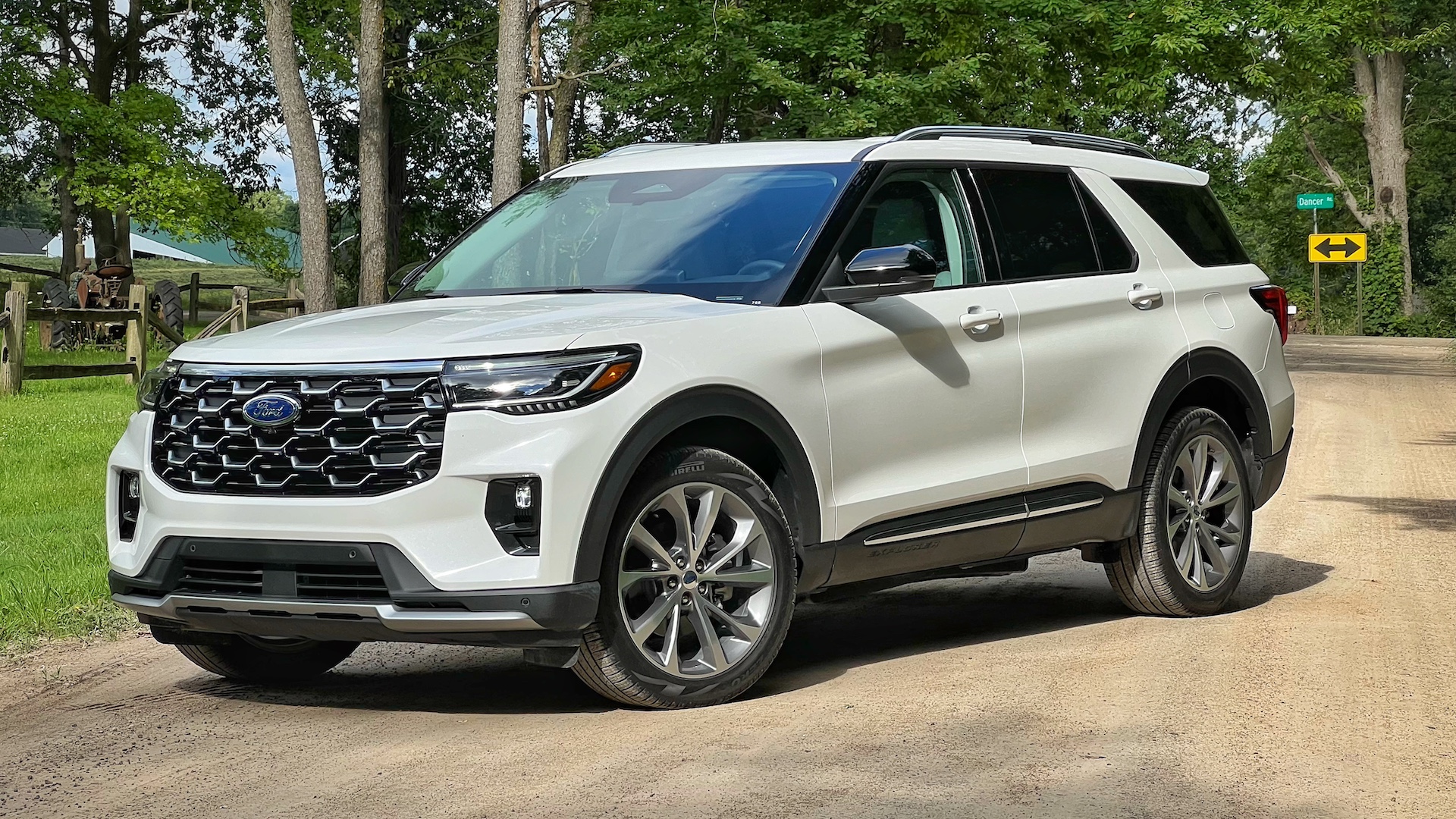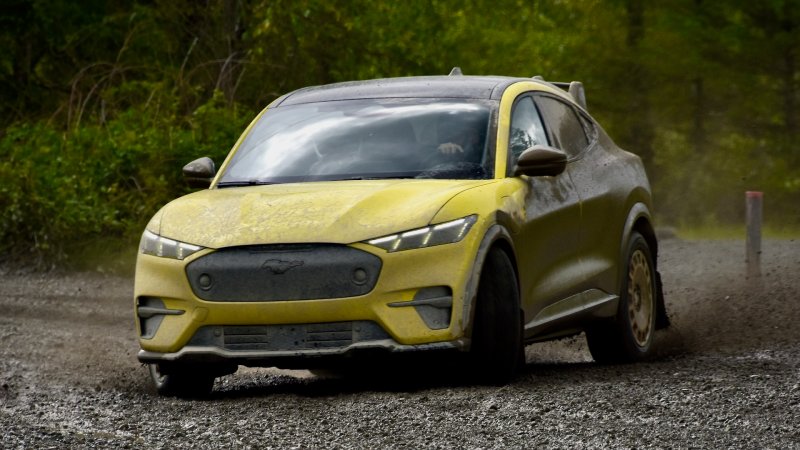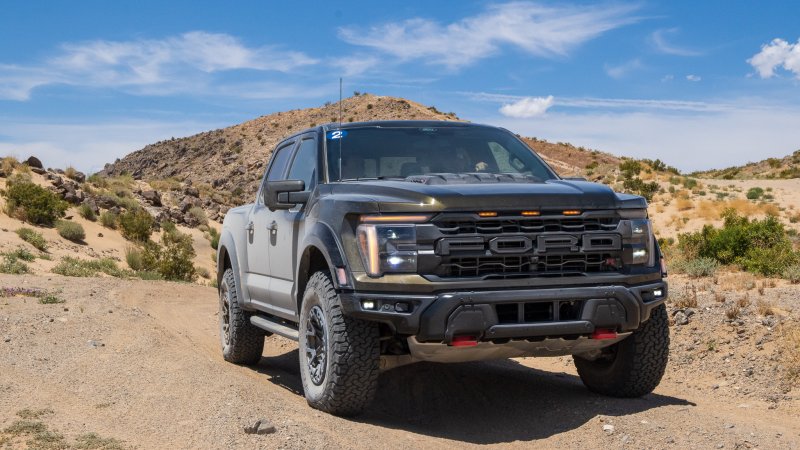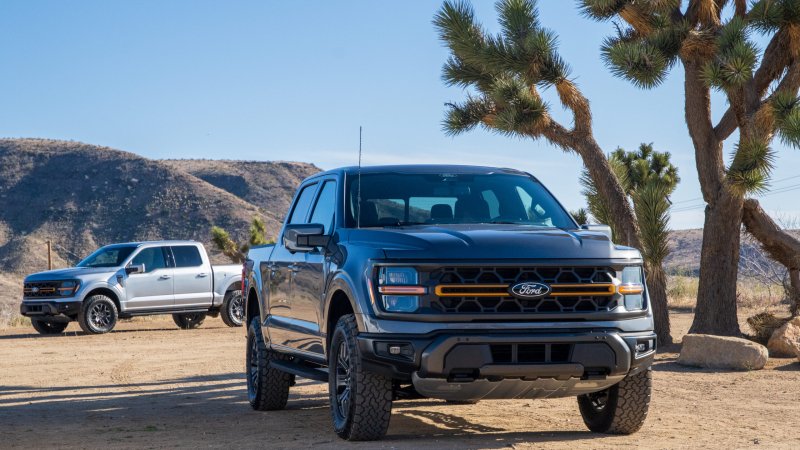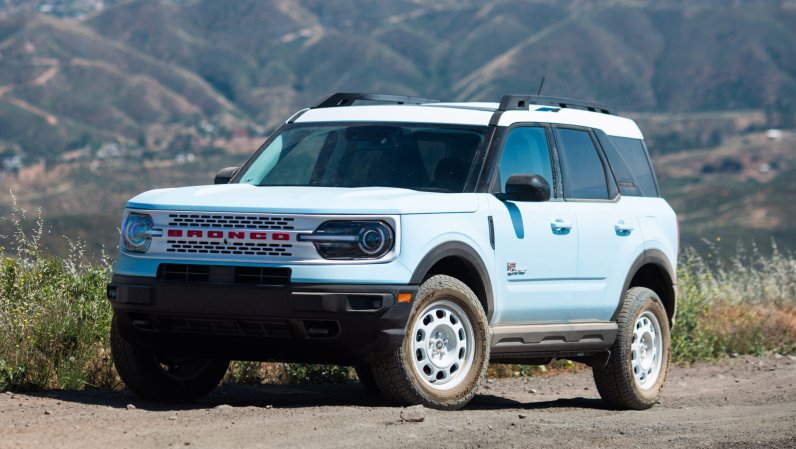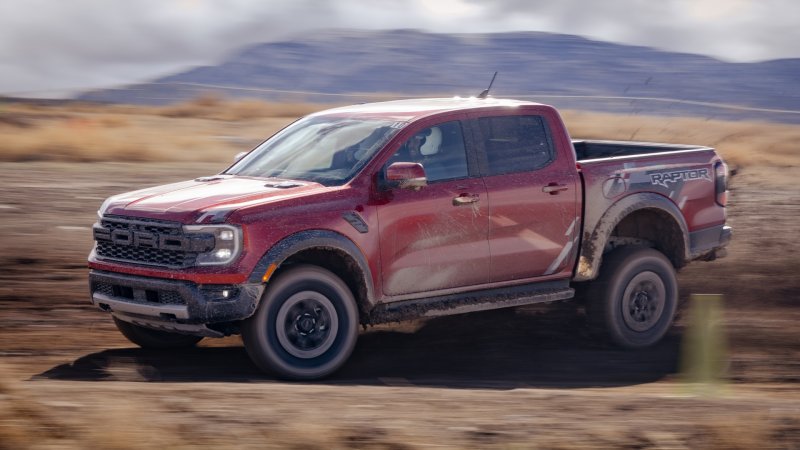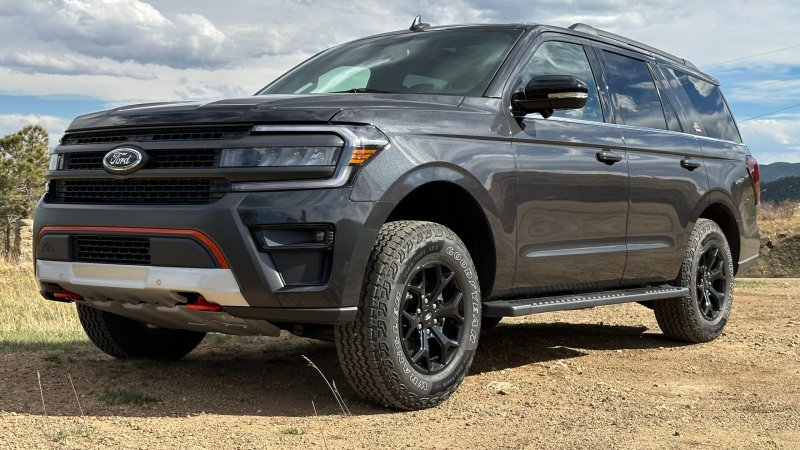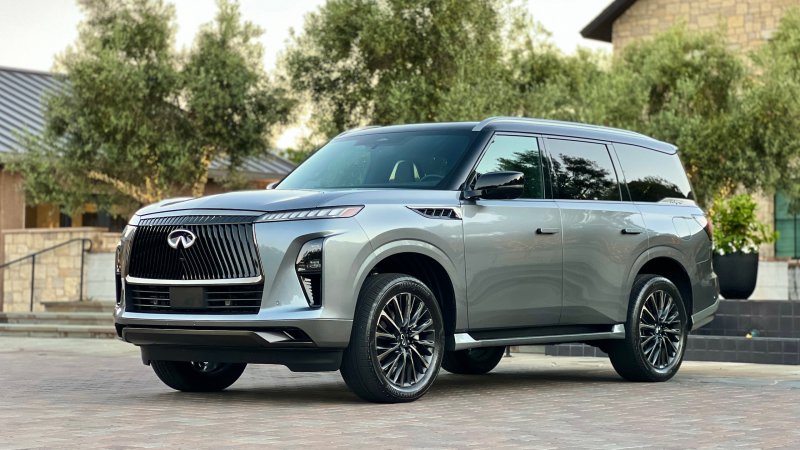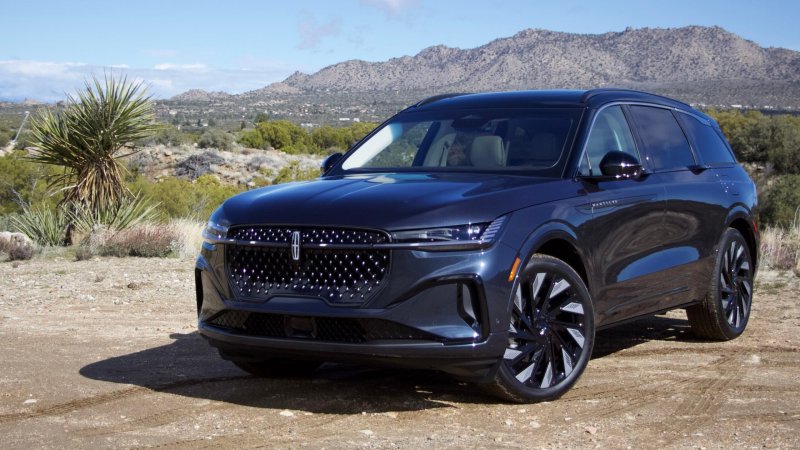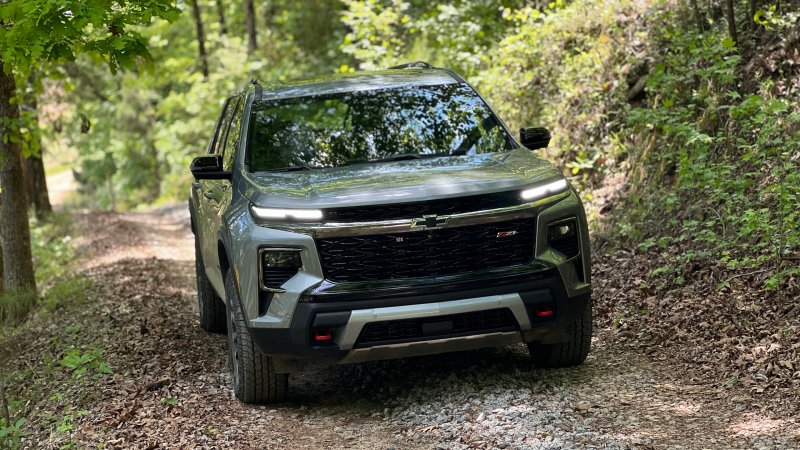The Ford Explorer is one of those nameplates that doesn’t need an introduction. Over 8 million of these have been sold worldwide since its debut in 1991—and eight body styles and six platforms later, it’s still the Blue Oval’s best-selling SUV. Long gone is the boxy styling that characterized the first generation, and who could forget the subsequent posh Eddie Bauer models? Nowadays, the three-row family hauler is much sleeker and more luxurious, though it’s better associated with law enforcement than Jurassic Park.
At its core, the 2025 Ford Explorer remains the same as before but boasts key updates to offer better value. Most of these occur inside, making the SUV more livable and practical for the daily grind. While the Explorer is a top seller in just about every demographic, families are still the primary buyers in this segment. And when it comes to the three-row category, many of its competitors have undergone complete redesigns halfway through the decade, meaning the Explorer has its work cut as it heads into the new year.



Ford opted for a fully new cabin design instead of a light refresh, giving the inside of the Explorer a more upscale and relaxed vibe than before. Starting with the all-new dashboard, it allowed designers to better incorporate the now-standard 12.3-inch digital gauge cluster as well as the standard 13.2-inch infotainment screen. The highlight of the new dashboard layout is the new lower console, which provides a much-needed place to store and charge a smartphone. Big enough for two smartphones or a phone and a wallet, or perhaps a phone, wallet, and keys, the console features a built-in wireless charger for one smart device.
It’s not just the design language that’s new but also the materials found throughout the cabin. New soft-touch materials have been implemented in the doors, including the card inserts and perhaps most importantly, the armrests. The dashboard’s beltline speaker is now wrapped in a new higher-end material that feels as good as it looks—not that I recommend you constantly touch it, however. Nothing changes in the second and third rows, though there are new interior colors available, including three dark themes and one light one with white leather and quilted stitching. There are two new Easter eggs: stamps on the sides of the dash with one depicting the Detroit skyline and the other of Chicago where the Explorer is assembled.







The SUV also gets a new face with new headlights, fog lights, and perhaps most noticeably, a new grille. The lower applique is also new, with redesigned intakes and skid plate elements. It makes for a classier look in the Platinum trim and a bolder face in the ST-Line and ST models. The rear end gets some love, too, with a fresh design across the liftgate’s beltline with “Explorer” badging, new taillights, and a new lower bumper. While not exactly a design thing, the Trailer/Tow package (read: tow hitch receiver) is now standard.
Explorer’s hierarchy remains unchanged for the new year, with Ford offering the SUV in the following trims: Active, ST-Line, ST, and Platinum. All models come standard with rear-wheel drive with four-wheel drive as an option.







I drove two different Explorer models during my test: a loaded-up Platinum trim with an MSRP of $60,660 (including $1,595 destination) and an ST-Line that came in approximately 8 grand cheaper. The Platinum gets the 400-horsepower, 3.0-liter twin-turbo V6 as standard, while the ST-Line rocks the feisty 2.3-liter turbocharged inline-four with 300 hp. On the road, this suburban family hauler feels smaller and, regardless of engine choice, zippier than you’d expect. The V6 graces you with more torque and keeps pulling strong longer than its smaller counterpart. But what the four-banger lacks in power, it makes up in responsiveness and overall character. The smaller engine that comes in the base Active and ST-Line trims is sportier-sounding under acceleration, and ultimately nicer when it comes to audio. The V6’s grunt isn’t pleasant, and even worse, too much engine noise seeps into the cabin during normal driving. I’d expect better for 60 bands.
Both engines do a solid job at delivering power when needed, whether it’s at the low end while driving around town, or at the top when passing on the highway. Again, while the V6 has more oomph, I was never left wanting more out of the four-banger regardless of the driving scenario. I wish I could say the same about the standard 10-speed automatic transmission which feels clunky and appears confused more often than not during city driving. Accelerate hard off the line and the transmission will have a hard time figuring out which gear to settle on once you ease off the throttle. It’s a similar case while shifting between drive and reverse while parking or maneuvering. This leads me to another annoyance of mine: the rotary dial shifter. Like in the Maverick Tremor I drove last year, I wish it was relocated elsewhere to free up more console space.






Let’s talk steering. In the Platinum trim, it’s not awful, it’s not great. It’s mostly numb. Taking a corner at 50-plus mph will take a little searching to find the right amount of steering input. It’s mostly calibrated for comfortable, everyday driving so it’s not a demerit, per se. This is slightly improved in the full-blown ST model, which I drove for about 55 seconds on an autocross course. Set to sport mode, it provided better feedback, though I still found numb spots throughout the SUV’s turning radius.
Poorly kept Michigan roads highlighted the Explorer’s plush suspension, which even in ST-Line configuration felt comfortable when dealing with potholes, cracked concrete, and uneven surfaces. This became apparent, too, while driving on unpaved, gravel roads. Despite both SUVs riding on 21-inch wheels, the suspension absorbed road imperfections with ease, and things never felt jarring through the seat or the steering wheel. Ford did a good job calibrating the suspension to ensure all passengers rode comfortably because whether you’re going to work or taking a 1,000-mile road trip, no one wants a stiff or unforgiving ride in a vehicle like this.






A big addition to the 2025 Explorer is the availability of Ford’s Blue Cruise 1.2 hands-free driving assist. During a short test of the system, I was impressed with how far Blue Cruise has come in a couple of years. In-lane positioning was far more precise than the previous version I drove in the Ford Lightning, something which is much appreciated when navigating a corner and passing an 18-wheeler at the same time. Blue Cruise coverage has also extended since the last time I tested the system, offering more interstates and other types of public roads.
The Active and ST-Line models pack all the features people want in a car nowadays for around $40,000 to $50,000 depending on trim. They look good, they drive well, and you don’t have to pay extra for things like wireless Apple CarPlay/Android Auto, Co-Pilot360, adaptive cruise, the tow package, and heated front seats. Once you move up to the ST and Platinum trims, however, some of that value proposition begins to slip away, especially considering how nice top-trim Toyotas, Hondas, and Hyundais are nowadays. Paying $60,000 for an Explorer Platinum is a tough pill to swallow when you take a look at a Hyundai Palisade Caligraphy, for example.
Overall, the 2025 Ford Explorer remains a good enough ride to make everyone’s short-list when shopping for a new three-row SUV.
| 2025 Ford Explorer Specs | 2.3-liter four-cylinder | 3.0-liter V6 |
|---|---|---|
| Base Price (as tested) | $41,350 ($52,845) | $57,100 ($60,660) |
| Powertrain | 2.3-liter turbo four-cylinder | 10-speed automatic | rear- or all-wheel drive | 3.0-liter turbo V6 | 10-speed automatic | rear- or all-wheel drive |
| Horsepower | 300 | 400 |
| Torque | 310 lb-ft | 415 lb-ft |
| Seating Capacity | 6 or 7 | << |
| Cargo Volume | 16.3 cubic feet behind third row | 46.0 cubic feet behind second row | 85.8 cubic feet behind first row | 16.3 cubic feet behind third row | 46.0 cubic feet behind second row | 85.3 cubic feet behind first row |
| Curb Weight | 4,303 pounds | 4,631 pounds |
| Max Towing | 5,000 pounds | << |
| Ground Clearance | 7.6 inches 8.2 inches (Platinum) | 7.8 inches (ST) 8.2 inches (Platinum) |
| EPA Fuel Economy | 20 mpg city | 27 highway | 23 combined (AWD) 20 mpg city | 29 highway | 24 combined (RWD) | 18 mpg city | 25 highway | 21 combined |
| Quick Take | The nicest Explorer yet gets the job done. | |
| Score | 7/10 |
Got a tip? Email me at tips@thedrive.com
